FES를 결합한 보행 훈련기가 만성 뇌졸중 환자의 보행과 균형에 미치는 영향
Ⅰ. 서 론
1. 연구의 필요성
2. 이론적 배경
3. 연구목적
4. 연구가설
Ⅰ-1. 연구의 필요성
운동기능 장애 중 보행의 장애는 뇌졸중 후 갖게 되는 최대의 상실감이다.
- Mumma, 1986
뇌졸중 후 보행 장애는 기능적 독립 수준과 예후에 부정적인 영향을 초래하므로 보행 능력의 재획득은 환자의 독립성과 직결되는 중요한 요소로서 재활치료의 목표 중 하나이다.
- Barbeau & Visintin, 2003
Ⅰ-1. 연구의 필요성
보행을 위하여 필수적이고 기본적인 요소는 균형이며, 보행과 균형의 결손은 실질적으로 뇌졸중 후 오랜 기간 장애에 기여한다.
- Shumway-cook et al., 1998; Duncan et al., 2007
뇌졸중 환자는 뇌 손상으로 인해 균형감각의 소실, 운동 조절력의 감소 및 근력약화로 인해 신체 안정성이 결여됨으로써 균형 조절 능력이 상실되어 양측 하지에 대칭적인 체중지지가 불가능하고 이로 인해 자세동요(postural sway)가 증가된다.
- Cheng et al., 1988
Ⅰ-1. 연구의 필요성
편마비 환자의 비정상적 자세 제어와 체중 분배를 해결하기 위하여 수 많은 중재 방법들이 연구되어지고 있으며, 이러한 중재방법은 트레이드밀 훈련, 체중지지, 부분적인 체중지지 트레이드밀 훈련, 지상 보행, 과제 특이적 보행 훈련 등을 포함한다.
- Daly et al., 2007
하네스 지지와 함께 트레이드밀 훈련은 뇌졸중 후 편마비를 가진 사람들의 이동 기능을 회복시키는 기대되는 과제 특이적 접근이다.
- Lindguist et al., 2007
Ⅰ-1. 연구의 필요성
최근 시스템 검토는 과제 특이적 보행훈련이 뇌줄중 후 보행 결과를 향상시킬 수 있다는 강력한 증거가 있음으로 결론내리고 있다.
- Foly et al., 2006; van Peppen et al., 2004
기능적 전기 자극(Functional Electrical Stimulation, FES)의 치료적 중재는 마비측 하지의 집중적인 근력 강화로 인하여 뇌졸중 환자의 분리되지 않는 협응적 움직임 형태 안에 마비측 하지의 조절 능력을 개선할 수 있다.
- Combs et al., 2007
Ⅰ-1. 연구의 필요성
FES와 체중지지를 병행한 트레이드밀 훈련이 운동 회복의 향상을 이끌고, 편마비를 가진 환자의 보행 패턴을 향상시킬 수 있다고 보고되었다.
- Lindqusit et al.,2007
최근 연구에서부분적인 체중지지와 FES를 결합한 트레이드밀 훈련이 전통적인 지상보행 훈련보다 하지근력, FAC(Functional Ambulatory Category) 척도에서 유의하게 향상되었음이 보고되었다.
- Ng et al., 2008; Tong et al., 2006
김수민(2004). PNF와 순환운동의 집단훈련이 재가 뇌졸중 장애인의 운동기능 향상에 미치는 효과, 대구대학교 대학원.
Barbeau H., Ladoucer M., Mirbagheri M. M. Kearney R. Z. (2002). The effect of locomotor training combined with functional electrical stimulation in chronic spinal cord injured subjects : walking and reflex studies. Brain Res Rev, 40; 274-291.
Barbeau H., Visintin M. (2003). Optimal outcome obtained with body-weight support combined with treadmill training in stroke patients. Arch Phys Med Rehabil, 84(10); 1458-1465.
Cheng P.T., Liaw M.Y, & Wong M.K.(1998). The sit to stand movement in stroke patient and its correlation with falling. Arch Phys Med Rehabil, 79(9) ; 1043 -1046.
Combs S., Miller E. W., Forsyth E. (2007). Motor and functional outcomes of a patient post-stroke following combined activity and impairment level training. Physiother Theory Pract, 23(4); 219-229.
Classen J., Liepert S. P., Hallett M., Cohem L. G. (1998). Rapid plasticity of human cortical movement representation induced by practice. Journal of Neurophysiology, 79(2); 1117-1123.
Coralie K., Susan L., Kathy R. et al. (2007). Circuit class therapy versus individual physiotherapy sessions during inpatient stroke rehabilitation : a controlled trial. Arch Phys Med Rehabil, 88; 955-963.
참고문헌
Daly J.J., Ruff R. L.(2007). Construction of Efficacious Gait and Upper Limb Functional Interventions Based on Brain Plasticity Evidence and Model-Based Measures For Stroke Patients. The Scientific World Journal, 7;2031-2045
Duncan P.W., Sullivan K. J. et al.(2007). Protocol for the Locomotor Experience Applied Post-stroke (LEAPS) trial: a randomized controlled trial. BMC Neurology, 7(39);1471-2377.
Foley N., Teasell R., Bhogal S. (2006). Evidence based review of stroke rehabilitation : mobility and the lower extremity.
Franceschini M., Carda S., Agosti M., Antemucci R., Malgrati D. & Cisari C.(2009). Walking after stroke ; what does treadmil training with body weight support add to overground gait training in patients early after stroke : a single-blind, randomized, controlled trial. Stroke, 40(9) ; 3079 - 3085.
Gentile A. M. (2000). Skill acquisition : action, movement and neuromotor processes. In: Carr J. H., Shepherd R. B., eds. Movement Science : Foundation for Physical Therapy. 2nd ed. Gaithersburg : Aspen, 111-187.
Gibson E. J. (1969). Principle of Perceptual Learning and Development. New York : Meredith.
참고문헌
Lindquist A.R.R., Prado C.L., Barros R.M.L., et al.(2007). Gait training combining partial body-weight support , a treadmil and functional electrical stimulation : effect on poststroke gait. Phy Ther, 87 ; 1147 - 1154.
Mayple F.W.NG., Tong R.K.Y., Li L.S.W.(2009). A pilot study of randomized clinical controlled trial of gait training in subacute stroke patient with partial body-weight support electromedical gait trainer and functional electrical stimulation. Stroke, 39 ; 154 - 160
Mumma C. M. (1986). Perceived losses following stroke Rehabil Nursing, 11; 19-24.
Ng F. W., Tong, R. K., & Li, L. S. (2008). A Pilot of Randomized Clinical Controlled Trial of Gait Training in Subacute Stroke Patients With Partial Body-Weight Support Electromechanical Gait Trainer and Functional Electrical Stimulation, Six-Month Follow-Up. Stoke, 39(1), 154-60.
Schmidt R. A., Lee T. D. (1998). Motor Control and Learning : A Behavioural Emphasis. 3rd ed. Champaign, Ⅲ : Human Kinetics.
Shumway - Cook A., Anson D, & Haller S.(1998). Postural sway biofeedback : its effects on reestablishing stance stability in hemiplegic patient. Arch Phys Med Rehabil, 69(6) ; 395 -400.
참고문헌
Tong K. Y., Ng, F. W., Li, S. W., & So, F. M. (2006). Gait training of patients after stroke using an electromechanical gait trainer combined with simultaneous functional stimulation. Phys Ther, 86(9), 1282-1294.
Van de Crommert H. W., Mulder T., Duysens J. (1998). Neural control of loconotion : sensory control of the central pattern generator and its relation to treadmill training. Gait Posture, 7; 251-263.
van Peppen R. P. S., Kwakkel G., Wood-Dauphinee S. et al. (2004). Effects of augmented exercise therapy time after stroke : a meta-analysis. Stroke, 35; 2529-2536.
Woolf C.J., Salter M.W.(2000). Neuronal Plasticity : Increasing the gain in pain. Science, 228 ; 1765 - 1768.



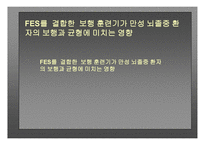
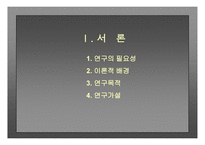


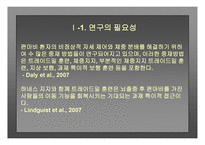
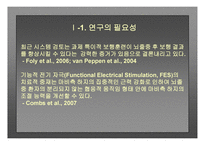
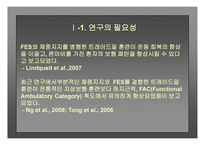
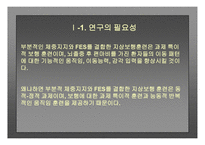

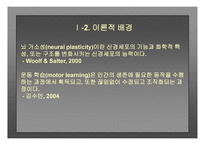
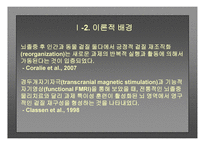
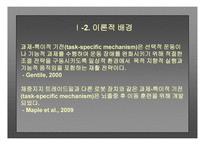
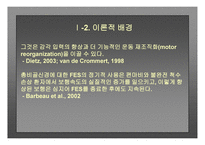

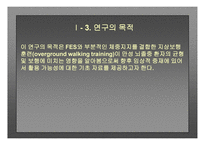
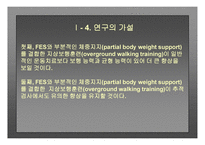
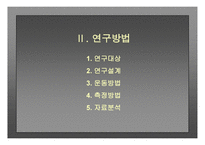
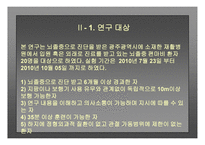
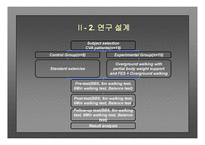
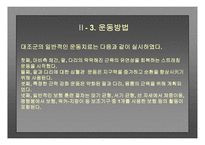
 분야
분야


